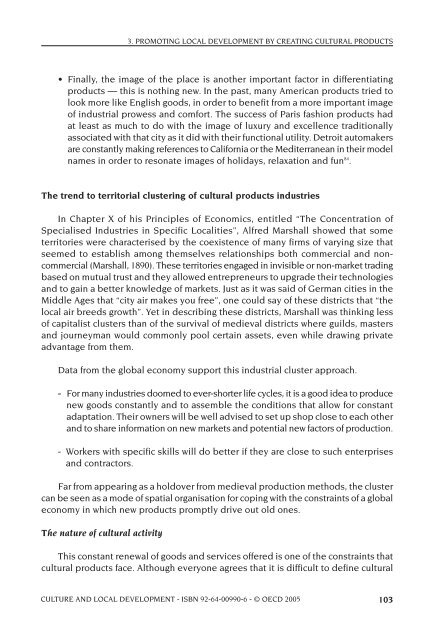OECD Culture and Local Development.pdf - PACA
OECD Culture and Local Development.pdf - PACA
OECD Culture and Local Development.pdf - PACA
Create successful ePaper yourself
Turn your PDF publications into a flip-book with our unique Google optimized e-Paper software.
3. PROMOTING LOCAL DEVELOPMENT BY CREATING CULTURAL PRODUCTS<br />
• Finally, the image of the place is another important factor in differentiating<br />
products — this is nothing new. In the past, many American products tried to<br />
look more like English goods, in order to benefit from a more important image<br />
of industrial prowess <strong>and</strong> comfort. The success of Paris fashion products had<br />
at least as much to do with the image of luxury <strong>and</strong> excellence traditionally<br />
associated with that city as it did with their functional utility. Detroit automakers<br />
are constantly making references to California or the Mediterranean in their model<br />
names in order to resonate images of holidays, relaxation <strong>and</strong> fun 84 .<br />
The trend to territorial clustering of cultural products industries<br />
In Chapter X of his Principles of Economics, entitled “The Concentration of<br />
Specialised Industries in Specific <strong>Local</strong>ities”, Alfred Marshall showed that some<br />
territories were characterised by the coexistence of many firms of varying size that<br />
seemed to establish among themselves relationships both commercial <strong>and</strong> noncommercial<br />
(Marshall, 1890). These territories engaged in invisible or non-market trading<br />
based on mutual trust <strong>and</strong> they allowed entrepreneurs to upgrade their technologies<br />
<strong>and</strong> to gain a better knowledge of markets. Just as it was said of German cities in the<br />
Middle Ages that “city air makes you free”, one could say of these districts that “the<br />
local air breeds growth”. Yet in describing these districts, Marshall was thinking less<br />
of capitalist clusters than of the survival of medieval districts where guilds, masters<br />
<strong>and</strong> journeyman would commonly pool certain assets, even while drawing private<br />
advantage from them.<br />
Data from the global economy support this industrial cluster approach.<br />
- For many industries doomed to ever-shorter life cycles, it is a good idea to produce<br />
new goods constantly <strong>and</strong> to assemble the conditions that allow for constant<br />
adaptation. Their owners will be well advised to set up shop close to each other<br />
<strong>and</strong> to share information on new markets <strong>and</strong> potential new factors of production.<br />
- Workers with specific skills will do better if they are close to such enterprises<br />
<strong>and</strong> contractors.<br />
Far from appearing as a holdover from medieval production methods, the cluster<br />
can be seen as a mode of spatial organisation for coping with the constraints of a global<br />
economy in which new products promptly drive out old ones.<br />
The nature of cultural activity<br />
This constant renewal of goods <strong>and</strong> services offered is one of the constraints that<br />
cultural products face. Although everyone agrees that it is difficult to define cultural<br />
CULTURE AND LOCAL DEVELOPMENT - ISBN 92-64-00990-6 - © <strong>OECD</strong> 2005 103














